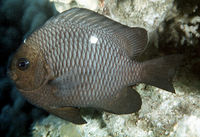Difference between revisions of "Dascyllus trimaculatus"
From The Aquarium Wiki
m |
|||
| Line 36: | Line 36: | ||
|max_water_hardness=12 | |max_water_hardness=12 | ||
}} | }} | ||
| − | |||
| − | |||
| − | |||
| − | |||
| − | + | == Tank compatibility == | |
| + | :A highly aggressive fish, aggression will increase as it matures. Do not keep with timid fish. Can be kept in male/female pairs. Can be kept in a semi-aggressive large community, with larger [[:Category:Dottyback|Dottybacks]], [[:Category:Angelfish (Saltwater)|Angelfish]] and [[:Category:Puffer Fish (Saltwater)|Puffers]]. This fish will also host anemones and will generally not harm invertebrates. | ||
| + | |||
| + | |||
| + | == Behaviour == | ||
| + | :A territorial and boisterous fish, especially if kept singly, this only increases with age. | ||
| + | |||
| + | |||
| + | == Identification == | ||
| + | :Oval, almost round body shape, a deep grey-blue colour. As juveniles they are black with a whitespot on the forehead and one on each side, as the fish matures the body colour lightens and the spots fade. | ||
| + | |||
| + | |||
| + | |||
{{Categories | {{Categories | ||
|Category=Fish, Fish (Saltwater), Damselfish | |Category=Fish, Fish (Saltwater), Damselfish | ||
Revision as of 03:09, 13 December 2017
Domino Damselfish
Dascyllus trimaculatus
208 Litres (55 US G.)
12.7-15.2cm (5-6 ")
8.2 - 8.5
22.2-23.9°C (72 -75 °F)
8-12 °d
1:1 M:F
2-5 years
Family
Pomacentridae
| You can contribute to the Aquarium Wiki by expanding this article. Dont be shy!. |
Contents
Additional names
- Domino Damselfish, Threespot Dascyllus, Threespot Damsel, 3-Spot Domino Damsel
Additional scientific names
- Pomacentrus trimaculatus
Tank compatibility
- A highly aggressive fish, aggression will increase as it matures. Do not keep with timid fish. Can be kept in male/female pairs. Can be kept in a semi-aggressive large community, with larger Dottybacks, Angelfish and Puffers. This fish will also host anemones and will generally not harm invertebrates.
Behaviour
- A territorial and boisterous fish, especially if kept singly, this only increases with age.
Identification
- Oval, almost round body shape, a deep grey-blue colour. As juveniles they are black with a whitespot on the forehead and one on each side, as the fish matures the body colour lightens and the spots fade.
Pictures
External links
- Fishbase (Mirrors:
 )
)

